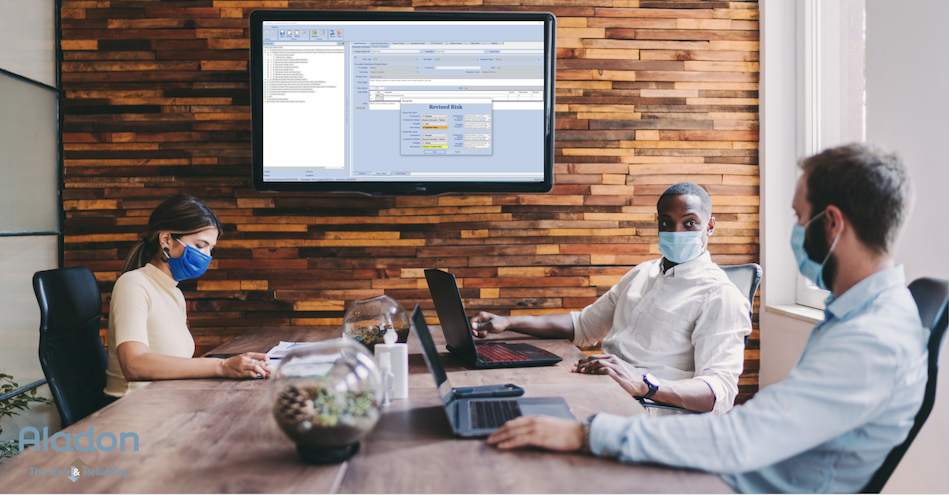For decades we at Aladon guided organizations to become more resilient and prepared for what otherwise seems unpredictable by building a reliability culture. With proper training, implementation and support and strong relationships, we’ve seen this system work for thousands of clients around the world.
And then with little warning, the pandemic continues to test the strength and resilience of businesses worldwide.
Businesses are having to rethink the way they interact and operate no matter how sophisticated their reliability culture. Even those industries faring better in the pandemic–like technology–are still adjusting the way they operate as employees work remotely.
The stronger the reliability culture, the more resilient in 2021
What we have seen and learned in the last year is this: those organizations most prepared by using the Aladon approach – are better positioned to survive and thrive in 2021.
This is because Reliability Centered Maintenance, first introduced by the airline industry in 1978 and industrialized as RCM2 by Aladon founder John Moubray in the 1980s, is the proven method to help organizations create a reliability culture. Today we’ve built upon that foundation with our added suite of thoughtware so that organizations can have a top down line of site approach to the entire life cycle of a physical asset.
But building a reliability culture is a process that requires extensive training, support and even years to fully implement. Businesses in a pandemic, paired with a global recession, are seeking immediate results with remote work in the foreseeable future which is directly opposed to the basic requirements of successful change management and sustainability.
Here’s how businesses will continue to pursue reliability in 2021 and beyond
Key to successfully implementing a reliability culture in 2021 is a robust strategy founded in proven methodologies and supported with an integrated software solution, says Aladon’s CEO Marius Basson. It’s through software that teams can work remotely and minimize the number of people who need to be on site or in a control room. And it’s with software that the operations and maintenance team can show some immediate benefits to the C-suite and finance team.
Kris Hahn, Aladon Senior Consultant and Technology Manager, says, “The idea of people walking around doing inspections in a plant have completely changed with remote work.”
Instead, organizations are installing sophisticated equipment sensors, as well as other means like using drones to capture information in real time. Advanced organizations are using machine learning like IBM’s Watson to analyze the data points, detect changes and alert the team. However, most companies don’t think through their data collection strategy with the best ways to utilize the data so little data today is actually analyzed. Hahn says “You can’t just put alarms on everything to create predictive forecasts.”
Hahn compares all the possible data points from machines to the human body. “If you draw blood to check a person’s health, you have to know which numbers to track in order to detect a problem. Methodologies like Aladon’s suite of thoughtware solutions are key to knowing what data matters to get a picture of asset health,” says Hahn.
Software, sensors, data and machine learning can all combine to make a business safer, more responsible and reliable, but only if they are measuring the right performance indicators and have an appropriate response to the data. With Aladon’s software solution, Hahn says, “We tell you what specific variables to watch and monitor them with dashboards. If something is out of whack, you know to review it and implement a pre-built job plan.”
Software backed by thoughtware is the vehicle to building a reliability culture in 2021
The right software, integrated with proven thoughtware is what allows businesses to make data-driven decisions even in an economy where nothing is predictable anymore.

Basson says,
“Our new software solution, ACTOR allows us to remotely train an organization’s maintenance and operations (M&O) team in a hands-on way so that they can implement our suite of thoughtware. It’s user friendly, easy to understand and provides the short term reward of making incremental progress that normally takes longer to notice in conventional training courses.”
With software, the Aladon team provide more immediate feedback. “We want to see organizations make defensible and sensible decisions, and when a decision does fall short, we provide almost real time feedback to ensure the business is staying consistent with the methodology and its overall strategy,” says Basson
But don’t be fooled.
Software is no magic bullet to building a reliability culture. It’s a tool.
“At Aladon, we believe you can’t buy reliability. You have to live it. Software backed by thoughtware is what allows businesses to operate reliably and make data-driven decisions,” says Basson
Since Aladon’s software launch in spring of 2019, clients are benefiting in the following ways:
- The leadership of businesses are more open to investing in software, which in turn allows the operations and management (O&M) team to kick start the long road to creating a reliability culture.
- The O&M team can make data-driven decisions about their physical assets and consistency is guaranteed.
- The data organizations are entering into the software is helping them capture knowledge that’s now even more crucial as fewer people are allowed in a plant’s control room or on a shift.
- Aladon’s software integrates with the organization’s existing programs, such as management software.
As much as the world changed in 2020, the process for organizations to be prepared for anything remains the same as we enter 2021. Organizations that are taking steps to use sensors, imaging technology, machine learning and software will still need to be committed to the principles of reliability that have worked in the past.
Hahn says it simply: “Know what assets you have, identify the critical ones, determine their condition, optimize your asset strategy, execute the strategy, analyze the data and adjust the strategy.”
